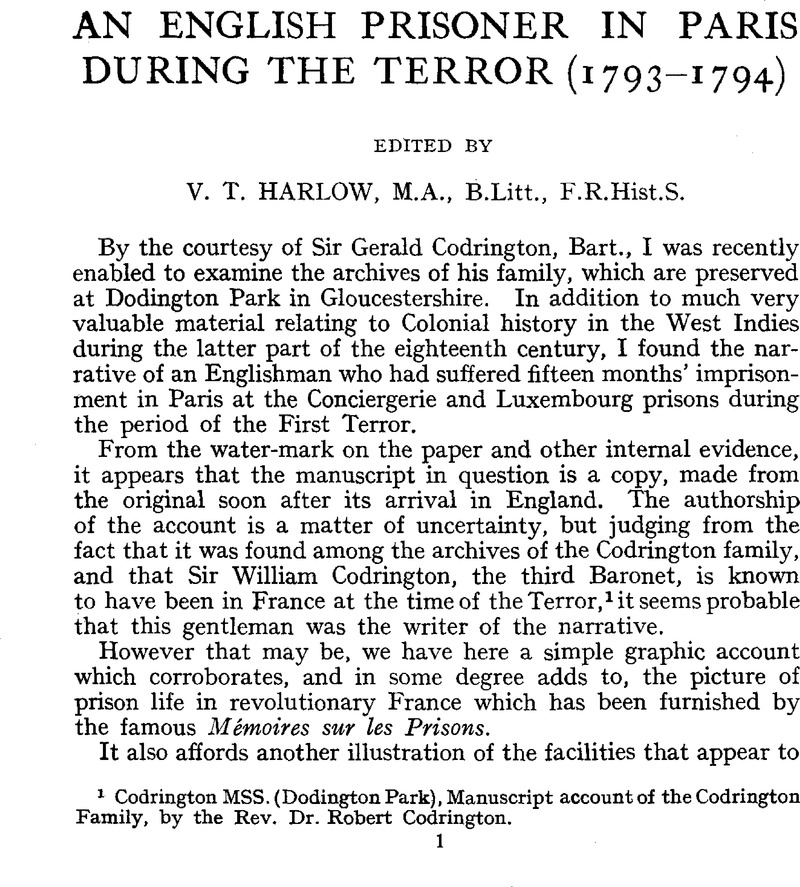No CrossRef data available.
Article contents
An English Prisoner in Paris During the Terror (1793–1794)
Published online by Cambridge University Press: 24 December 2009
Abstract

- Type
- Other
- Information
- Copyright
- Copyright © Royal Historical Society 1929
References
page 1 note 1 Codrington MSS. (Dodington Park), Manuscript account of the Codrington Family, by the Rev. Dr. Robert Codrington.
page 2 note 1 On 6 March, 1793, the Convention had sent two of its members into each department to superintend the raising of the great conscriptive levy decreed on 4 February. On the completion of this task they were ordered to remain in their districts, nominally to stamp out all anti-revolutionary plots, but chiefly to act as all-powerful pro-consuls under the central oligarchy.
page 2 note 2 Cf. Carlyle, , The French Revolution, 1903 edition, pp. 700–1Google Scholar. “Nantes Town is sunk in sleep; but Représentant Carrier is not sleeping, the woolcapped Company of Marat is not sleeping. Why unmoors that flat-bottomed craft, that gabarre, about eleven at night? … In the middle of the Loire stream, on signal given, the gabarre is scuttled; she sinks with all her cargo. ‘Sentence of Deportation,’ writes Carrier, ‘was executed vertically.’ ” Cf. also Histoire Générale, par Lavisse et Rambaud, Vol. VIII, p. 188, and the Cambridge Modern History, Vol. VIII, p. 356.Google Scholar
page 3 note 1 I.e., 3 January, 1795.
page 4 note 1 I.e., Toulon (on 28 August, 1793). Cf. Lavisse et Rambaud, Histoire Générale, Vol. VIII, p. 184.Google Scholar
page 7 note 1 About June, 1794, one hundred and thirty-two men of Nantes were sent under guard to march, chained two and two, for trial at Paris. According to Carlyle only ninety-four of them survived to the end of the journey. His statement that they were all Jacobins is open to question, but they were certainly not royalists or plotters against the Republic. “Vive la Republique,” he writes, “rises from them in all streets or towns: they rest by night in unutterable noisome dens, crowded to choking; one or two dead on the morrow ” (The French Revolution, p. 743Google Scholar). Those that survived the journey escaped the guillotine and lived to denounce the atrocities of Carrier at Nantes.
page 8 note 1 Cf. Madelin, Louis, The French Revolution (translated from the French), London, 1916, p. 373Google Scholar. “The Du Barry, poor antiquated beauty, had her turn; she simpered before the Tribunal and wept upon the scaffold, beseeching ‘M. le Bourreau’ to give her ‘one moment more.’ ”
page 9 note 1 Cf. Carlyle (op. cit.), p. 742. “Suspicious Municipality snatches from us all implements: all money and possession, of means or metal, is ruthlessly searched for, in pillow and paillasse, and snatched away; red-capped Commissaries entering every cell.”
page 9 note 2 “Only a few days before Thermidor rumours of approaching massacre had brooded over the prisons; and on the very eve of the coup d'état a batch of forty-five had been duly executed, thus missing reprieve by a few hours only” (Cambridge Modern History, Vol. VIII, p. 374Google Scholar). It is now known that an outbreak in support of Robespierre was being prepared for the 10th Thermidor. Probably a general massacre of all prisoners was part of the scheme (cf. Madelin, , op. cit., p. 416).Google Scholar
page 9 note 3 Temple Luttrell was the fourth son of Simon Luttrell (who was created 1st Earl of Carhampton in 1785) and Maria, daughter of Sir Nicholas Lawes, Governor of Jamaica. From 1774 to 1780 he sat as member of Parliament for Milborne Port, Somerset. He was arrested at Boulogne on 18 September, 1793, and confined in the Abbaye and Luxembourg prisons from 24 October of that year until 14 February, 1795. Owing to the fact that his elder sister, Anne, was the wife of the Duke of Cumberland, Luttrell was exhibited to the Paris mob as brother of the King of England (see Alger, , Englishmen in the French Revolution, pp. 148, 299, 341Google Scholar). After his release he lived on in Paris, where he died on 14 January, 1803 (Dict. Nat. Biog.).




